Popular categories
Looking for a yarn?

100% Cotton
from 1.85 £ /50g
Order DROPS Muskat from Wool Warehouse Direct Ltd

|
DROPS Muskat uni colour 100% Cotton |
1.85 £ /50g |
Order |
Clicking the ORDER button will redirect you to Wool Warehouse Direct Ltd website
Order DROPS Needles & Hooks
Clicking the ORDER button will redirect you to Wool Warehouse Direct Ltd website
The yarn cost is calculated from the pattern’s smallest size and the yarn’s cheapest product type. Looking for an even better price? You might find it on the DROPS Deals!
Breaking Waves Dress
Knitted DROPS dress with stripes and round yoke in ”Muskat”. Size: S - XXXL
DROPS design: Pattern no CL-001
--------------------------------------------------------
Size: S - M - L - XL - XXL - XXXL
The dress will be somewhat longer than the measurements in the chart when worn.
Materials: DROPS MUSKAT from Garnstudio
Colour no 60, ice blue:
200-200-250-250-250-300 g
Colour no 08, off white:
100-150-150-150-150-200 g
Colour no 01, light blue purple: 100-100-100-100-150-150 g
Colour no 61, light beige:
50-50-50-50-100-100 g
Colour no 76, sky blue:
100 g in all sizes
Colour no 02, light blue:
100 g in all sizes
Colour no 04, lilac:
50 g in all sizes
DROPS CIRCULAR NEEDLE (40 and 80 cm) SIZE 4 mm - or size needed to get 21 sts x 28 rows in stocking st = 10 x 10 cm.
DROPS DOUBLE POINTED NEEDLES AND CIRCULAR NEEDLE (40 cm) SIZE 3 mm - for edges.
-------------------------------------------------------
Alternative Yarn – See how to change yarns here
Yarn Groups A to F – Use the same pattern and change the yarn here
Yarn usage using an alternative yarn – Use our yarn converter here
-------------------------------------------------------

100% Cotton
from 1.85 £ /50g
Order DROPS Muskat from Wool Warehouse Direct Ltd

|
DROPS Muskat uni colour 100% Cotton 1.85 £ /50g Order |
Clicking the ORDER button will redirect you to Wool Warehouse Direct Ltd website
Order DROPS Needles & Hooks
Clicking the ORDER button will redirect you to Wool Warehouse Direct Ltd website
The yarn cost is calculated from the pattern’s smallest size and the yarn’s cheapest product type. Looking for an even better price? You might find it on the DROPS Deals!
- English (UK/cm)
- Česky
- Dansk
- Deutsch
- Eesti keel
- English (US/in)
- Español
- Français
- Íslenska - not translated
- Italiano
- Magyar
- Nederlands
- Norsk
- Polski
- Português
- Suomi
- Svenska
- English (UK/cm), Bulgaria
- English (UK/cm), Croatia
- English (UK/cm), Greece
- English (UK/cm), Latvia
- English (UK/cm), Lithuania
- English (UK/cm), Romania
- English (UK/cm), Slovenia
- Česky, Slovakia
Pattern instructions
1 ridge = 2 rounds * K 1 round and P 1 round *, repeat from *-*.
PATTERN:
See diagram M.1 (zigzag pattern) - diagram shows pattern from RS. And diagram M.3 (stripes).
DECREASE TIP (applies to zigzag pattern):
See M.2 for example. All dec are done on the rounds where pattern is worked. Dec 2 sts in every repetition by working as follows: 2 sts in same st, work until 3 sts remain before the middle of repetition, slip 1 st as if to K, K 2 tog, psso, K 3 tog. Work the rest of the repetition and finish by working 2 sts in the same st. On next round work as before but with 1 st less on each side of the middle.
INCREASE TIP:
Inc 1 st by making 1 YO, on next row K YO twisted (i.e. work in the back loop of st instead front) to avoid holes.
--------------------------------------------------------
DRESS:
Worked in the round on circular needle. Start the round at the side. Cast on 260-286-312-338-364-390 sts on 2 circular needles size 4 mm (to avoid a tight cast on edge) with light blue. Pull out one of the circular needles.
Work 4 rounds in GARTER ST - see explanation above. Then work zigzag pattern following chart M.1 (10-11-12-13-14-15 repetitions) and AT THE SAME TIME work stripes following chart M.3 (repeat M.3 until piece measures 54-55-56-57-58-59 cm). REMEMBER THE KNITTING TENSION!
AT THE SAME TIME when piece measures 12-12-11-11-14-14 cm from bottom tip, dec 2 sts in every repetition - READ DECREASE TIP! Repeat dec every 9-9-10-10-12-12 cm a total of 5-5-5-5-4-4 times = 160-176-192-208-252-270 sts (= 16-16-16-16-18-18 sts remain in every repetition). Continue to work until piece measures 54-55-56-57-58-59 cm. K 1 round with the colour used on last stripe while AT THE SAME TIME dec 12-12-12-6-26-18 sts evenly = 148-164-180-202-226-252 sts. Insert a marker at beg of round and a marker after 74-82-90-101-113-126 sts (markers = each side). Move the markers upwards when working.
Switch to ice blue and work in stocking st.
When piece measures 2-2-2-3-3-3 cm from the start of ice blue, inc 1 st on each side of both markers in each side (= 4 sts inc) - READ INCREASE TIP! Repeat inc every 2-2½-2½-2½-3-3 cm a total of 3 times = 160-176-192-214-238-264 sts, now ice blue section measures 6-7-7-8-9-9 cm. K 1 round with ice blue while AT THE SAME TIME casting off 8-8-8-10-10-10 sts in each side (i.e. 4-4-4-5-5-5 sts on each side of both markers) for armholes = 72-80-88-97-109-122 sts remain on front and back piece.
Cut the thread, put piece aside and knit the sleeves.
SLEEVE:
Worked in the round on double pointed needles. Cast on 60-66-69-75-78-81 sts on double pointed needles size 3 mm with off white. Insert a marker at beg of round (= mid under sleeve). Work in GARTER ST for 2 cm. Switch to double pointed needles size 4 mm and ice blue. K 1 round while AT THE SAME TIME casting off 8-8-8-10-10-10 sts mid under sleeve (4-4-4-5-5-5 sts on each side of marker) = 52-58-61-65-68-71 sts. Cut the thread, put piece aside and knit another sleeve.
YOKE:
Slip sleeves on to same circular needle size 4 mm as body where armholes were cast off = 248-276-298-324-354-386 sts. Insert a marker, NOW MEASURE PIECE FROM HERE! Work in stocking st in the round on circular needle size 4 mm with ice blue.
Start round mid back!
Size S + M + L: When piece measures 2 cm, dec 34-40-40 sts evenly (tighten the thread a little when working 2 and 2 sts tog to make dec less visible), repeat dec when piece measures 4 cm and 6 cm = 146-156-178 sts. When piece measures 8 cm, dec 20 sts evenly = 126-136-158 sts.
Size XL + XXL + XXXL: When piece measures 3 cm, dec 40-42-44 sts evenly (tighten the thread a little when working 2 and 2 sts tog to make dec less visible), repeat dec when piece measures 6 cm and 9 cm = 204-228-254 sts. When piece measures 12 cm, dec 20 sts evenly = 184-208-234 sts.
ALL SIZES: Now work an elevation in the back of neck with ice blue as follows (work in stocking st back and forth on needle): Insert a marker between the middle 2 sts at the front. Start mid back and work until 20 sts remain before marker mid front, turn piece, tighten thread and work until 20 sts remain before marker in the other side. Turn piece, tighten thread and work until 40 sts remain before marker mid front, turn piece, tighten thread and work until 40 sts remain before marker in the other side. Turn piece, tighten thread and work until 55-60-70-80-90-100 sts remain before marker mid front, turn piece, tighten thread and work until 55-60-70-80-90-100 sts remain before marker in the other side, turn and work until mid back.
NECKLINE:
Switch to circular needle size 3 mm and off white and work in garter st in the round on circular needle for 2 cm before loosely casting off.
ASSEMBLY:
Sew the openings under the sleeves.
Diagram

|
= K from RS, P from WS |

|
= work 2 sts in same st |

|
= slip 1 st as if to K, K 1, psso |

|
= K 2 tog |

|
= slip 1 st as if to K, K 2 tog, psso |

|
= K 3 tog |

|
= light blue |

|
= light blue purple |

|
= off white |

|
= ice blue |

|
= sky blue |

|
= light beige |

|
= lilac |
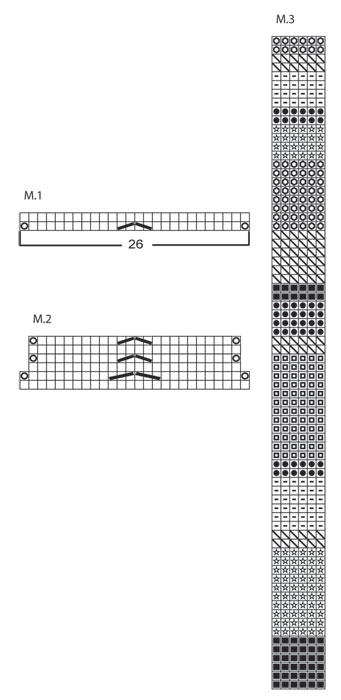
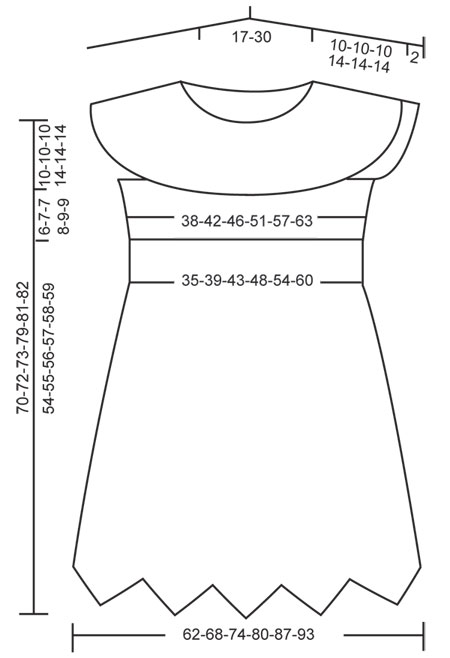
What can you do with our patterns? You can share DROPS patterns online, using the pattern original picture, materials, name and number. But you are NOT ALLOWED to reproduce the complete pattern digitally in any way. Yarn stores are welcome to use the DROPS pattern database to promote the sale of our assortment. You can print out our patterns, make as many copies as you’d like. The only thing we ask is that you don't make any changes / additions to the original printed document. And that the patterns according to the DROPS philosophy are given out to the consumers for free. Editorials that wish to publish our patterns in printed books or magazines can contact us for more information. The sale of garments based on DROPS patterns is permitted as long as they are sold as single items or per order. Further commercial use of the patterns is not permitted. It has to be clearly stated that the garment is made based on a design from DROPS DESIGN. The use of clothing labels of which DROPS DESIGN forms part is conditioned by the inclusion of the following text: “A DROPS DESIGN made by …..”. The use of DROPS photos for marketing purposes/sales is only permitted in connection with the use/sale of DROPS products. The photos may not be cut or edited and the logo should be clearly visible.
We reserve the right to withdraw the permission for use of our patterns at any time, notwithstanding the reason.
Each of our patterns has specific tutorial videos to help you.
These step-by-step tutorials might also help you:
Why is the knitting/crochet tension so important?
Knitting tension is what determines the final measurements of your work, and is usually measured per 10 x 10 cm. It is provided like so: number of stitches in width x number of rows in height - eg: 19 stitches x 26 rows = 10 x 10 cm.
The knitting tension is very individual; some people knit/crochet loosely while others work tightly. You adjust the knitting tension with the needle size, which is why the suggested needle size is only meant as a guide! You need to adjust this (up or down) to ensure that YOUR knitting tension matches the knitting tension provided in the pattern. If you work with a different knitting tension than provided you will have a different yarn consumption, and your work will have different measurements than what the pattern suggests.
The knitting tension also determines which yarns can replace each other. As long as you achieve the same knitting tension you can replace one yarn with another.
See DROPS lesson: How to measure your tension/gauge
See DROPS video: How to make a gauge tension swatch
How do I know how many balls of yarn I need?
The required amount of yarn is provided in grams, eg: 450 g. To calculate how many balls you’ll need you first need to know how many grams are in 1 ball (25g, 50g or 100g). This information is available if you click on the individual yarn quality on our pages. Divide the amount required with the amount of each ball. For example, if each ball is 50g (the most common amount), the calculation will be as follows: 450 / 50 = 9 balls.
Can I use a different yarn than what the pattern suggests?
The important thing when changing from one yarn to another is that the knitting/crochet tension remains the same. This is so that the measurements of the finished piece will be the same as on the sketch provided. It is easier to achieve the same knitting tension using yarns from the same yarn group. It is also possible to work with multiple strands of a thinner yarn to achieve the knitting tension of a thicker one. Please try our yarn converter. We recommend you to always work a test swatch.
Please NOTE: when changing yarn the garment might have a different look and feel to the garment in the photo, due to individual properties and qualities of each yarn.
See DROPS lesson: Can I use a different yarn than the one mentioned in the pattern?
What are the yarn groups?
All our yarns are categorised into yarn groups (from A to F) according to thickness and knitting tension – group A contains the thinnest yarns and group F the thickest. This makes it easier for you to find alternative yarns to our patterns, should you wish to switch yarn. All yarns within the same group have a similar knitting tension and can easily replace each other. However, different yarn qualities have different structures and properties which will give the finished work a unique look and feel.
How do I use the yarn calculator?
At the top of all our patterns you’ll find a link to our yarn calculator, which is a helpful tool should you wish to use a different yarn than suggested. By filling in the yarn quality you wish to replace, the amount (in your size) and number of strands, the calculator will present good alternative yarns with the same knitting tension. Additionally it will tell you how much you’ll require in the new qualities and whether you’ll need to work with multiple strands. Most skeins are 50g (some are 25g or 100g).
If the pattern is worked with multiple colours, every colour will have to be calculated separately. Similarly, if the pattern is worked with several strands of different yarns (for example 1 strand Alpaca and 1 strand Kid-Silk) you will have to find alternatives for each, individually.
Why do you show discontinued yarns in the patterns?
Since different yarns have different qualities and textures we have chosen to keep the original yarn in our patterns. However, you can easily find options among our available qualities by using our yarn calculator, or simply pick a yarn from the same yarn group.
It is possible that some retailers still have discontinued yarns in stock, or that someone has a few skeins at home that they would like to find patterns for.
The yarn calculator will provide both alternative yarn as well as required amount in the new quality.
What size should I knit?
If you think it's hard to decide what size to make, it can be a good idea to measure a garment you own already and like the size of. Then you can pick the size by comparing those measures with the ones available in the pattern's size chart.
You'll find the size chart at the bottom of the pattern.
See DROPS lesson: How to read size chart
Why do I get the wrong knitting tension with the suggested needle size?
The needle size provided in the pattern serves only as a guide, the important thing is to follow the knitting tension. And since knitting tension is very individual, you will have to adjust the needle size to ensure that YOUR tension is the same as in the pattern – maybe you’ll have to adjust 1, or even 2 needle sizes, up or down to achieve the correct tension. For this, we recommend that you work test swatches.
Should you work with a different knitting tension than the one provided, the measurements of the finished garment might deviate from the measurement sketch.
See DROPS lesson: How to measure your tension/gauge
See DROPS video: How to make a tension/gauge swatch
Why is the pattern worked top-down?
Working a garment top-down provides more flexibility and room for personal adjustment. For example it is easier to try the garment on while working, as well as making adjustments to length of yoke and shoulder caps.
The instructions are carefully explaining every step, in the correct order. Diagrams are adjusted to the knitting direction and are worked as usual.
How do I work according to a knitting diagram?
The diagram depicts all rows/rounds, and every stitch seen from the right side. It is read from bottom to top, from right to left. 1 square = 1 stitch.
When working back and forth, every other row is worked from the right side and every other row is worked from the wrong side. When working from the wrong side, the diagram will have to be worked reversed: from left to right, knit stitches are purled, purl stitches are knit etc.
When working in the round every round is worked from the right side and the diagram are worked from right to left on all rounds.
See DROPS lesson: How to read knitting diagrams
How do I work according to a crochet diagram?
The diagram depicts all rows/rounds, and every stitch seen from the right side. It is worked from bottom to top, from right to left.
When working back and forth every other row is worked from the right side: from right to left and every other row is worked from the wrong side: from left to right.
When working in the round, every row in the diagram are worked from the right side, from right to left.
When working a circular diagram you start in the middle and work your way outwards, counter clockwise, row by row.
The rows usually start with a given number of chain stitches (equivalent to the height of the following stitch), this will either be depicted in the diagram or explained in the pattern.
See DROPS lesson: How to read crochet diagrams
How do I work several diagrams simultaneously on the same row/round?
Instructions for working several diagrams after each other on the same row/round, will often be written like so: “work A.1, A.2, A.3 a total of 0-0-2-3-4 times". This means you work A.1 once, then A.2 is worked once, and A.3 is repeated (in width) the number of times provided for your size – in this case like so: S = 0 times, M = 0 times, L=2 times, XL= 3 times and XXL = 4 times.
The diagrams are worked as usual: begin with the first row in A.1, then work the first row in A.2 etc.
See DROPS lesson: How to read knitting diagrams
See DROPS lesson: How to read crochet diagrams
Why are the sleeves shorter in larger sizes?
The total width of the garment (from wrist-to-wrist) will be larger in the larger sizes, despite the actual sleeves being shorter. The larger sizes have longer sleeve caps and wider shoulders, so there will be a good fit in all sizes.
Where on the garment is the length measured?
The measurement sketch/schematic drawing provides information regarding the full length of the garment. If it’s a jumper or a jacket the length is measured from the highest point on the shoulder closest to the neckline, and straight down to the bottom of the garment. It is NOT measured from the tip of shoulder. Similarly, the length of yoke is measured from the highest point on the shoulder and down to where yoke is split into body and sleeves.
On a jacket measures are never taken along bands, unless specifically stated. Always measure inside band stitches when measuring the length.
See DROPS lesson: How to read a schematic drawing
What is a repeat?
Diagrams are often repeated on the round or in height. 1 repeat is the diagram the way it appears in the pattern. If it says to work 5 repeats of A.1 in the round, then you work A.1 a total of 5 times after/next to each other in the round. If it says to work 2 repeats of A.1 vertically/in height you work the entire diagram once, then begin again at the start and work the entire diagram one more time.
Why does the piece start with more chain stitches than it’s worked with?
Chain stitches are slightly narrower than other stitches and to avoid working the cast-on edge too tight, we simply chain more stitches to begin with. The stitch count will be adjusted on the following row to fit the pattern and measurement sketch.
Why increase before the rib edge when the piece is worked top-down?
The rib edge is more elastic and will contract slightly compared to, for example, stocking stitch. By increasing before the rib edge, you avoid a visible difference in width between the rib edge and the rest of the body.
Why increase in the cast-off edge?
It’s very easy to cast off too tightly, and by making yarn overs while casting off (and simultaneously casting these off) you avoid a too tight cast off edge.
See DROPS video: How to bind off with yarn overs (yo)
How do I increase/decrease on every 3rd and 4th row/round alternately?
To achieve an even increase (or decrease) you can increase on, for example: every 3rd and 4th row alternately, like so: work 2 rows and increase on the 3rd row, work 3 rows and increase on the 4th. Repeat this until the increase is complete.
See DROPS lesson: Increase or decrease 1 st on every 3rd and 4th row alternately
How can I work a jacket in the round instead of back and forth?
Should you prefer to work in the round instead of back and forth, you may of course adjust the pattern. You’ll need to add steeks mid-front (usually 5 stitches), and follow the instructions. When you would normally turn and work from the wrong side, simply work across the steek and continue in the round. At the end you’ll cut the piece open, pick up stitches to work bands, and cover the cut edges.
See DROPS video: How to knit steeks and cut open
Can I work a jumper back and forth instead of in the round?
Should you prefer to work back and forth instead of in the round, you may of course adjust the pattern so you work the pieces separately and then assemble them at the end. Divide the stitches for the body in 2, add 1 edge stitch in each side (for sewing) and work the front and back pieces separately.
See DROPS lesson: Can I adapt a pattern for circular needles into straight needles?
Why is the pattern slightly different than what I see in the photo?
Pattern repeats can vary slightly in the different sizes, in order to get the correct proportions. If you’re not working the exact same size as the garment in the photo, yours might deviate slightly. This has been carefully developed and adjusted so that the complete impression of the garment is the same in all sizes.
Make sure to follow instructions and diagrams for your size!
How do I make a women’s size garment into a men’s size one?
If you have found a pattern you like which is available in women’s size it’s not very difficult to convert it to men’s size. The biggest difference will be the length of sleeves and body. Start working on the women size that you think would fit across the chest. The additional length will be worked right before you cast off for the armhole/sleeve cap. If the pattern is worked top-down you can add the length right after the armhole or before the first decrease on sleeve.
Regarding additional yarn amount, this will depend on how much length you add, but it is better with a skein too many than too few.
How do I prevent a hairy garment from shedding?
All yarns will have excess fibres (from production) that might come off as lint or shedding. Brushed yarns (ie hairier yarns) have more of these loose, excess fibres, causing more shedding.
Shedding also depends on what is worn under or over the garment, and whether this pulls at the yarn fibres. It’s therefore not possible to guarantee that there will be no shedding
Below are some tips on how to get the best result when working with hairier yarns:
1. When the garment is finished (before you wash it) shake it vigorously so the looser hairs come off. NOTE: do NOT use a lint roller, brush or any method that pulls at the yarn.
2. Place the garment in a plastic bag and put it in your freezer - the temperature will cause the fibres to become less attached to each other, and excess fibres will come off easier.
3. Leave in the freezer for a few hours before taking it out and shaking it again.
4. Wash the garment according to the instructions on the yarn label.
Why does my garment pill?
Pilling is a natural process that happens to even the most exclusive of fibers. It's a natural sign of wear and tear that is hard to avoid, and that is most visible in high friction areas of your garment like a sweater's arms and cuffs.
You can make your garment look as new by removing the pilling, using a fabric comb or a pill/lint remover.
In the meantime, you can read the questions and answers that others have left to this pattern or join the DROPS Workshop on Facebook to get help from fellow knitters/crocheters!
Breaking Waves Dress |
||||||||||||||||||||||||||||||||||||||||
 |
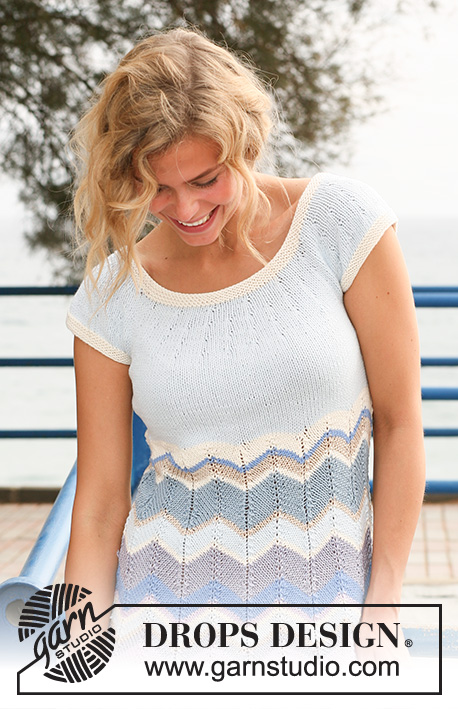 |
|||||||||||||||||||||||||||||||||||||||
Knitted DROPS dress with stripes and round yoke in ”Muskat”. Size: S - XXXL
DROPS 128-35 |
||||||||||||||||||||||||||||||||||||||||
|
GARTER ST (in the round on circular needle): 1 ridge = 2 rounds * K 1 round and P 1 round *, repeat from *-*. PATTERN: See diagram M.1 (zigzag pattern) - diagram shows pattern from RS. And diagram M.3 (stripes). DECREASE TIP (applies to zigzag pattern): See M.2 for example. All dec are done on the rounds where pattern is worked. Dec 2 sts in every repetition by working as follows: 2 sts in same st, work until 3 sts remain before the middle of repetition, slip 1 st as if to K, K 2 tog, psso, K 3 tog. Work the rest of the repetition and finish by working 2 sts in the same st. On next round work as before but with 1 st less on each side of the middle. INCREASE TIP: Inc 1 st by making 1 YO, on next row K YO twisted (i.e. work in the back loop of st instead front) to avoid holes. -------------------------------------------------------- DRESS: Worked in the round on circular needle. Start the round at the side. Cast on 260-286-312-338-364-390 sts on 2 circular needles size 4 mm (to avoid a tight cast on edge) with light blue. Pull out one of the circular needles. Work 4 rounds in GARTER ST - see explanation above. Then work zigzag pattern following chart M.1 (10-11-12-13-14-15 repetitions) and AT THE SAME TIME work stripes following chart M.3 (repeat M.3 until piece measures 54-55-56-57-58-59 cm). REMEMBER THE KNITTING TENSION! AT THE SAME TIME when piece measures 12-12-11-11-14-14 cm from bottom tip, dec 2 sts in every repetition - READ DECREASE TIP! Repeat dec every 9-9-10-10-12-12 cm a total of 5-5-5-5-4-4 times = 160-176-192-208-252-270 sts (= 16-16-16-16-18-18 sts remain in every repetition). Continue to work until piece measures 54-55-56-57-58-59 cm. K 1 round with the colour used on last stripe while AT THE SAME TIME dec 12-12-12-6-26-18 sts evenly = 148-164-180-202-226-252 sts. Insert a marker at beg of round and a marker after 74-82-90-101-113-126 sts (markers = each side). Move the markers upwards when working. Switch to ice blue and work in stocking st. When piece measures 2-2-2-3-3-3 cm from the start of ice blue, inc 1 st on each side of both markers in each side (= 4 sts inc) - READ INCREASE TIP! Repeat inc every 2-2½-2½-2½-3-3 cm a total of 3 times = 160-176-192-214-238-264 sts, now ice blue section measures 6-7-7-8-9-9 cm. K 1 round with ice blue while AT THE SAME TIME casting off 8-8-8-10-10-10 sts in each side (i.e. 4-4-4-5-5-5 sts on each side of both markers) for armholes = 72-80-88-97-109-122 sts remain on front and back piece. Cut the thread, put piece aside and knit the sleeves. SLEEVE: Worked in the round on double pointed needles. Cast on 60-66-69-75-78-81 sts on double pointed needles size 3 mm with off white. Insert a marker at beg of round (= mid under sleeve). Work in GARTER ST for 2 cm. Switch to double pointed needles size 4 mm and ice blue. K 1 round while AT THE SAME TIME casting off 8-8-8-10-10-10 sts mid under sleeve (4-4-4-5-5-5 sts on each side of marker) = 52-58-61-65-68-71 sts. Cut the thread, put piece aside and knit another sleeve. YOKE: Slip sleeves on to same circular needle size 4 mm as body where armholes were cast off = 248-276-298-324-354-386 sts. Insert a marker, NOW MEASURE PIECE FROM HERE! Work in stocking st in the round on circular needle size 4 mm with ice blue. Start round mid back! Size S + M + L: When piece measures 2 cm, dec 34-40-40 sts evenly (tighten the thread a little when working 2 and 2 sts tog to make dec less visible), repeat dec when piece measures 4 cm and 6 cm = 146-156-178 sts. When piece measures 8 cm, dec 20 sts evenly = 126-136-158 sts. Size XL + XXL + XXXL: When piece measures 3 cm, dec 40-42-44 sts evenly (tighten the thread a little when working 2 and 2 sts tog to make dec less visible), repeat dec when piece measures 6 cm and 9 cm = 204-228-254 sts. When piece measures 12 cm, dec 20 sts evenly = 184-208-234 sts. ALL SIZES: Now work an elevation in the back of neck with ice blue as follows (work in stocking st back and forth on needle): Insert a marker between the middle 2 sts at the front. Start mid back and work until 20 sts remain before marker mid front, turn piece, tighten thread and work until 20 sts remain before marker in the other side. Turn piece, tighten thread and work until 40 sts remain before marker mid front, turn piece, tighten thread and work until 40 sts remain before marker in the other side. Turn piece, tighten thread and work until 55-60-70-80-90-100 sts remain before marker mid front, turn piece, tighten thread and work until 55-60-70-80-90-100 sts remain before marker in the other side, turn and work until mid back. NECKLINE: Switch to circular needle size 3 mm and off white and work in garter st in the round on circular needle for 2 cm before loosely casting off. ASSEMBLY: Sew the openings under the sleeves. |
||||||||||||||||||||||||||||||||||||||||
Diagram explanations |
||||||||||||||||||||||||||||||||||||||||
|
||||||||||||||||||||||||||||||||||||||||

|
||||||||||||||||||||||||||||||||||||||||

|
||||||||||||||||||||||||||||||||||||||||
|
Have you made this or any other of our designs? Tag your pictures in social media with #dropsdesign so we can see them! Do you need help with this pattern?You'll find tutorial videos, a Comments/Questions area and more by visiting the pattern on garnstudio.com. © 1982-2024 DROPS Design A/S. We reserve all rights. This document, including all its sub-sections, has copyrights. Read more about what you can do with our patterns at the bottom of each pattern on our site. |
||||||||||||||||||||||||||||||||||||||||
With over 40 years in knitting and crochet design, DROPS Design offers one of the most extensive collections of free patterns on the internet - translated to 17 languages. As of today we count 304 catalogues and 11422 patterns - 11422 of which are translated into English (UK/cm).
We work hard to bring you the best knitting and crochet have to offer, inspiration and advice as well as great quality yarns at incredible prices! Would you like to use our patterns for other than personal use? You can read what you are allowed to do in the Copyright text at the bottom of all our patterns. Happy crafting!







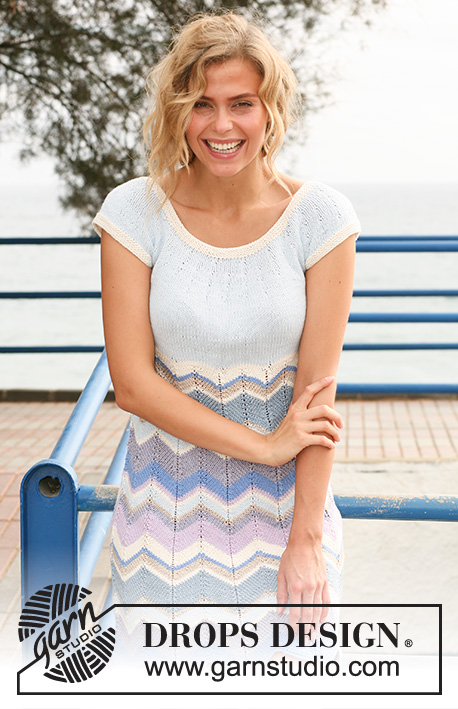
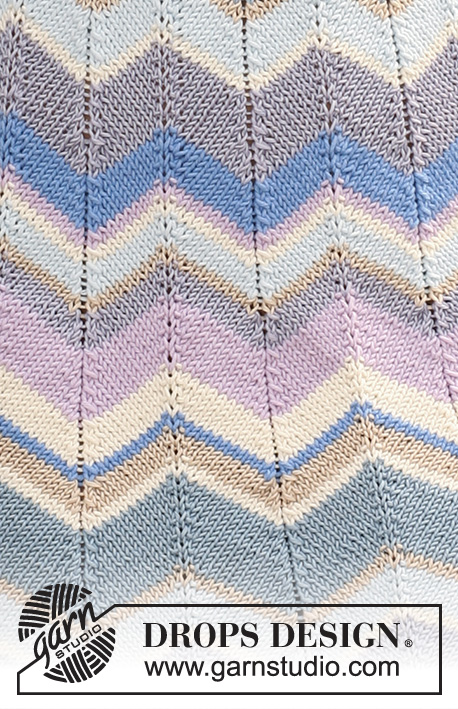


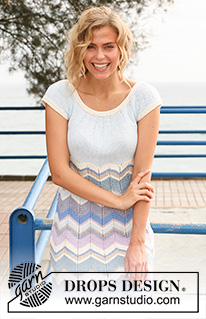



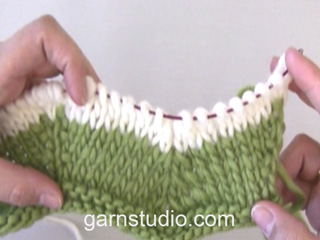








































Comments / Questions (109)
Aiemmin (0.8.04. 20204) esittämäni kysymyksen saa poistaa, olin ymmärtänyt ohjeen väärin!
17.04.2024 - 11:56Miksi ohjeessa kohdassa Kavennusvinkki neuvotaan neulomaan samaan silmukkaan 2 s, koska sehän päinvastoin lisää silmukoita, ei kavenna, ja tekee siis tyhjäksi koko kavennuksen? Kavennukseenhan riittäisi mainiosti, että kavennetaan mallikerran keskellä, eli tässä ei ole järkeä.
08.04.2024 - 15:19DROPS Design answered:
Hei, mallikertaan lisätään 2 silmukkaa, mutta samalla kavennetaan yhteensä 4 silmukkaa. Eli kavennuskerroksen jälkeen mallikerrassa on 2 silmukkaa vähemmän.
08.04.2024 - 17:58Hallo, Ich habe in Größe L begonnen und merke nun beim 1.Abnehmen,dass die Größe nicht stimmt. Ich stricke mit Nadelstärke 3. und einen Seidengarn. Statt 74 cm (Diagramm) sind es bei mir knapp 50 cm, bei Größe XXL wären es dann 15 cm mehr, also 65 cm. Kommt das durch das ZickZack Muster? Wenn ich in XXL stricke, oder größer, passt die Maschenanzahl dann auch für das Oberteil und die Passe? Vielen Dank für die Hilfe, Nadja
12.11.2023 - 08:48DROPS Design answered:
Liebe Nadja, stimmt Ihre Maschenprobe? Sie sollen 21 Maschen glatt rechts = 10 cm haben; im ZickZackmuster braucht man dann mehr Maschen für dieselbe Breite, aber solange Ihre Maschenprobe stimmt, dann sollte die fertigen Maßen wie in der Skizze stimmen. Viel Spaß beim stricken!
13.11.2023 - 08:00Det står strikk 2 masker i en maske, skal det da økes eller felles? Det var litt vanskelig å forstå.
09.06.2023 - 15:37DROPS Design answered:
Hei Anne. Når du strikker 2 masker i samme maske, øker du med 1 maske. Når du strikker etter diagram M.1 & M.2, så øker du i begynnelsen og slutten av diagrammene, men du feller masker midt i diagrammene, slik at maske antallet forblir det sammen (bortsett fra 2. rad i M.2 der du minsker maskeantallet). NB! I diagram M.3 betyr den sorte sirkelen at du skal strikke med farge syrin, ikke strikk 2 masker i samme maske. mvh DROPS Design
12.06.2023 - 08:42Opskrift DROPS 128-35, Hvilke farver der skal købes passer ikke sammen med flere farver i forklaring til farver i diagrammet. Jeansblå er ikke i oversigten til garnkøb, og hvor skal farven 02 lys blå bruges i diagrammet? Efter hvad jeg kan se, findes den slet ikke i diagrammet. men på billedet af modellen er den. Svar udbedes så hurtigt som muligt da jeg ikke kan komme i gang med at strikke, før jeg har fået et svar. Mvh Ilse Rasmusssen
06.07.2022 - 17:55DROPS Design answered:
Hej Ilse, Lys blå er døbt om til Jeansblå i diagrammet men findes stadigvæk som lys blå 02. Det her er en ældre model og farverne er ændret en smule med tiden. 01 lys blålilla hedder 01 lavendel og er samme farve. Farve 76 er samme som 76 lys denim. De andre farver er samme :)
07.07.2022 - 08:44Oj vad jag fick kämpa med mönstret, trots att det inte var svårt egentligen. Ett tips är att använda markörer med 26 maskors mellanrum Jag missade först att göra två maskor i samma maska även i den 26:e maskan. Det blir ju två maskor i samma både i början och slutet av mönstret.
05.07.2022 - 17:54Witam - gdzie używamy schematu M.2 (?). Pozdrawiam, Lucyna
01.07.2021 - 07:13DROPS Design answered:
Witaj Lucyno, w momencie gdzie zaczynamy zamykać oczka w zygzaku (w każdym motywie), czyli we wzorze na wys. 12-12-11-11-14-14 cm, mierząc od dolnych ząbków, będziemy przerabiać schemat M.2. Patrz ZAMYKANIE OCZEK (zygzak). Pozdrawiamy!
01.07.2021 - 14:50W opisie Rekawy ile trzeba zrobic cm rekawa kolorem stalowy błekit ,jest napisane 2 cm kolorem ecru i co dalej?
01.07.2020 - 09:53DROPS Design answered:
Witaj Kasiu, we wzorze jest napisane, aby przerabiać ściegiem francuskim kolorem ecru przez 2 cm, a po przerobieniu tych 2 cm, zacząć przerabiać na drutach pończoszniczych nr 4 już kolorem stalowy błękit. Pozdrawiamy!
01.07.2020 - 16:20Wann stricke ich mit M2?
08.06.2019 - 09:05DROPS Design answered:
Liebe Sabine, M.2 wird gestrickt, wenn man abnehmen muss - z.B. wenn die Arbeit 12-12-11-11-14-14 cm misst, wird es abgenommen, wie unter TIPP ZUM ABNEHMEN (gilt für das Zick-Zack-Muster) beschrieben. Viel Spaß beim stricken!
11.06.2019 - 09:58Skal jeg bruke m2 hver 9 cm eller starte på igjen etter at jeg har strikket 6 omganger
17.02.2019 - 17:29DROPS Design answered:
Hei Ingrid. Du skal gjenta fellingen på hver 9. cm. Ellers strikker du mønster som før. M.2 viser den aller første gangen du feller, men du feller på samme måte hver gang - bare at det vil være ferre masker mellom maskene du strikker 2 masker i, og fellingen på midten. Altså på hver 9 cm strikker du slik: ved å strikke slik: 2 m i samme m, strikk til det gjenstår 3 m før midten i rapporten, ta 1 m løs av p som om den skulle strikkes rett, 2 rett sammmen, løft den løse m over, etter midten strikkes 3 m rett sammen. Fortsett ut rapporten og avslutt med å strikke 2 m i samme m. God fornøyelse
21.02.2019 - 09:58